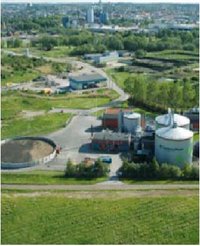Oil phase-out in Sweden
There is growing concern about the global oil situation with the world now finding one new barrel of oil for every four it consumes. This fact, coupled with growing concern regarding climate change, motivated Sweden to begin its shift to oil independence. In December of 2005, the government of Sweden set up the Commission on Oil Independence to implement policy development concerning Sweden's energy consumption. Including members from academic institutions, private companies, public organizations, and government agencies, the Commission's main objective is to advise the Swedish government regarding how to reduce the nation's dependence on oil by 2020. The Commission cites five reasons for phasing out Sweden’s dependency on oil, improving the efficiency of energy use, and eventually replacing fossil energy sources with renewable energy:
- To reduce Sweden’s climate impact
- To secure Sweden’s supply of energy in the long term
- To become a leading nation in the development of new technology for a sustainable (Sustainomics and sustainable development) and more efficient use of energy
- To strengthen Sweden's international economic competitiveness
- To utilize and develop "Sweden's green gold" (the energy resources from forests and fields)
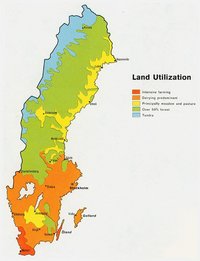 Sweden's land use (Source: University of Texas)
Sweden's land use (Source: University of Texas) The Commission stresses throughout the proposal that "use of oil" is not synonymous with "dependence on oil." Their measures aim to reduce as much actual consumption of oil as possible by 2020. They also want to reduce the one-sided dependence on oil in areas where total independence from oil will take much longer to achieve, such as the transport sector. The use of oil and the process of the "oil phase-out in Sweden" will continue after 2020.
Contents
Overview of Proposal The Commission’s proposals are based on the following five overall strategies: (Oil phase-out in Sweden)
Improve energy efficiency
The Commission believes that for the oil phase-out to be successful, it needs to improve the energy efficiency of society as a whole. According to the Commission, using energy more efficiently means that the same products are produced and the same level of prosperity is maintained at a lower level of energy consumption. It stresses that a more effective use of energy not only reduces nuclear power emissions, but better manages renewable energy sources. Lastly, the Commission believes that a 20% improvement in energy efficiency by 2020 will lead to an expanding business sector fueled by clean technology. </p>
Sweden has one of the largest acreage of forest per inhabitant in the European Union. In addition to food, its forests yield large amounts of energy crops that can be used for heating, electricity, and propellants. The Commission proposes that in the coming years, Sweden should devote more of its forests to producing this type of bioenergy. Making major investments in the production of energy from forests and fields can help to replace the use of fossil fuels for industrial and commercial needs.
In order to carry out this strategy without negatively affecting nature conservation and outdoor recreation, the Commission created the following stipulations:
- Forest growth must be increased by 15-20% through more efficient clearing, the use of refined plant material, ditch clearing, and fertilization, along with intensified cultivation of spruce and broad-leaf trees.
- Energy crops must be cultivated on arable and disused farmland on a scale of 300,000 to 500,000 hectares.
- The Swedish Government must invest funds to educate the public about bioenergy, provide subsidies, procure new technology, and build production facilities for these crops.
Electricity for a sustainable supply of energy
Since Sweden's use of electricity is high compared to that of other developed nations, the Commission aims to reduce its consumption throughout society. To accomplish this, the Commission proposes that:
- Swedish industry improve carbon dioxide by 40%, and that residential and commercial buildings by 20%
- The Swedish government and industry cooperate to increase production of domestic renewable energy by extending wind power and researching new sources of power such as solar cells, wave power, and hydrogen gas for fuel cells
- Reduce electricity use for heating buildings by producing more efficient climate shells and installations, increasing the use of IT-based systems for a higher level of efficiency, and switching to biofuel-fired district heating, environmentally approved wood biolers, pellet burners, and pellet stoves.
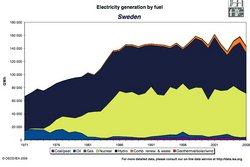 Sweden's electricity generation by fuel (Source: International Energy Agency)
Sweden's electricity generation by fuel (Source: International Energy Agency) Decreased role for natural gas
One of the most controversial aspects of the Commission's proposal is its view on natural gas. Although the Commission realizes that natural gas could replace a certain amount of oil used in industrial processes, it fears that it could replace domestically produced biofuels used in heating and district heating power plants, thus hurting Sweden's bioenergy industry and actually increasing the emissions of carbon dioxide. For these reasons, the Commission advises that the government does not commit itself to increasing the use of natural gas. Rather, the government should support local infrastructures for biogas.
Reduce carbon emission rights at EU level
The European Union (European Union Emissions Trading Scheme (EU ETS)) is committed to reducing energy consumption and energy waste as well as to meeting the conditions set by the Kyoto Protocol. To do this, the EU focuses on energy-intensive sectors: construction, manufacturing, electricity generation, and transportation. In 2006, the EU stated its goal to cut the annual primary energy consumption by 20% by 2020. The Commission believes that in order to reach higher energy efficiency and develop other fuels, the EU emission trading system for carbon dioxide, which began in 2005, should gradually lower the number of emission rights. If the distribution of these rights decreases so that by 2020 total emissions in the trading sector is reduced by 25%, there will be stronger incentive to reduce emissions of carbon dioxide, and thereby to reduce the consumption of oil.
Following these strategies will enable Sweden to accomplish the following three major objectives by 2020:
- In principle, no oil should be used for heating residential and commercial buildings
- Road transport, including transport in the agricultural, forestry, fisheries and building sectors, should reduce use of petrol and diesel by 40-50%
- Industry should reduce its use of oil by 25-40%
Accomplishing these goals will enable Swedish society as a whole should be able to make 20% more efficient use of energy by 2020 and at the same time create intensified, cost-effective prosperity that leads to a sustainable future.
Goals for Residential and Commercial Buildings
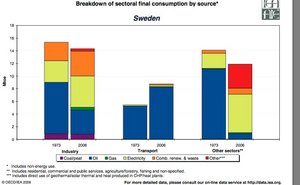 Breakdown of energy consumption by sector (Source: International Energy Agency)
Breakdown of energy consumption by sector (Source: International Energy Agency) In order to make housing more energy efficient, economical, and ecologically sustainable, no oil should be used in the heating of residential and commercial buildings, and the direct use of electricity should be decreased. By relying on intelligent control of lighting, heating, and ventilation, and the development of new technology, new housing should combine energy efficiency with attractiveness, and existing housing must be modernized to significantly reduce energy consumption.
Of most importance to the Commission is replacing oil with biofuels, preferably in combination with solar energy (Photovoltaics). As of 2006, approximately half of inhabited space in Sweden obtains its heat through district heating.In areas without district heating, whereby steam or hot water is distributed to multiple buildings, they should be connected to the district heating network through creating more biofuel-fired heating plants. These plants should be supplemented by power plant technology that produces electricity as well as heat. At the time of the proposal's commencement, about 6.6 Tera Watt Hours (TWh)electricity was produced in district-heating plants. The Commission hopes that this number will increase to around 26 TWh by 2020.
The Commission proposes the following measures that should constitute the framework for national efforts to achieve higher efficiency of energy use in residential and commercial buildings:
- Improve efficiency in construction of new housing
The Government and the building industry should collaborate to construct a high proportion of low energy houses based on reliable and advanced technology such as tight climate shells, advanced heat exchange, and intelligent control systems of electricity. Though the Commission realizes that this type of housing will be more expensive to build, the amount of energy saved, and thus the amount of money saved, will trump the cost of construction. To ensure that the new housing is environmentally sustainable, building regulations related to energy conservation should be tightened, and since currently all new buildings are entitled to a real estate tax deduction for the first five years, the Commission proposes that the size of the deduction be linked to energy efficiency.
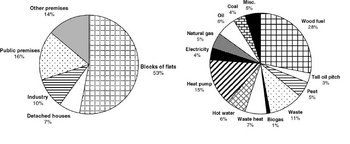 Consumers and fuels used for district heating in Sweden (Source: Energy Policy)
Consumers and fuels used for district heating in Sweden (Source: Energy Policy) - Improve efficiency in existing residential and commercial buildings
The existing housing stock needs to be renovated and modernized to give a higher level of energy efficiency. To encourage modernization, the Commission believes that the government should implement a Programme for Improving Energy Efficiency (PIEE) for property owners. The participating property owners, if they act in accordance with the government's Energy Declaration, would receive tax deductions for environmentally sound installations (e.g. solar panels) and stimulus checks for training their caretakers and management personnel. To successfully improve efficiency in existing housing across Sweden, the government needs to make an effort to educate consumers and tenants as well as members of the building sector (purchasers, planners, entrepreneurs, and craftsmen) about energy efficiency improvement methods. The best way to educate, the Commission stresses, is to be a good example. State-built, state-owned, and state-administered buildings must reduce energy consumption first by following their own stipulations in their Energy Declaration. A similar aim should apply to other public entities, such as schools and hospitals.
Goals for Transportation
The European Union uses 31% of its energy for transportation alone. Currently, 23% of total CO2-equivalents in the European Union come from transportation vehicles; however, this is expected to increase unless countries enact policies to change the trend. The Commission foresees reducing their oil usage by 50% by 2020 and continuing thereafter until they have achieved oil independence. In the context of the proposal, transportation vehicles refer to vehicles used in all sectors of society including those used onfarms, fisheries, and construction sites.
The Commission proposes the following measures:
- Increased efficiency of private vehicles
By 2020, Sweden's private vehicles should be made 25-50% more efficient. First, the Commission suggests that the government should push its people to use a higher proportion of diesel vehicles, as diesel technology proves to be around 25-30% more efficient than petrol. Despite acknowledging that diesel vehicles currently emit more nitric oxide than petrol vehicles, the Commission feels that pressure from the EU concerning new exhaust requirements will lead to decreased emissions. In the long-term, Sweden intends to replace all vehicles with those powered by biofuels and hybrid technology. The Commission believes that in the future more than half of the energy needs of a private car will be met via electricity from renewable energy sources. To create incentives for the public to support this measure, the Commission suggests introducing a tax on carbon dioxide based on vehicle type, preferential taxation of company cars when fuel-efficient alternatives are encouraged, and an energy and carbon dioxide tax on fuel.
While traditional combustion engines are becoming more efficient, they are only predicted to further increase energy efficiency by about 20%. As a transition between gasoline vehicles and alternative fuel vehicles, hybrid technologies are currently being developed and promoted. These vehicles could potentially reduce energy use by up to 50%. Research and development for fully electric vehicles includes work on podcars, which would increase energy efficiency by 70%. Podcars, also known as personal rapid transit or urban light transport, are an adaptation of electrically driven vehicles that can run on rails with or without a driver. However, this calls for a complete rearrangement of the transport system and is therefore, still a stretch.
- Improved efficiency and alternative transportation of goods
The Swedish government must ensure that the dependence on oil in the transport sector is ended in a way that does not damage domestic companies and the local economy. To do this, the Commission states that the amount of goods that vehicles can carry should be increased, and engine technology of these vehicles should be upgraded so oil consumption can be reduced. There should also be a gradual changeover from fossil fuels to biofuels in vehicles that transport goods. Coupled with increasing the load of goods single vehicles transport by road, the government should also explore alternative ways of transporting goods. Cities should utilize transportation of goods by railroad if possible. Another interesting alternative is sea transportation, which has on average a six times lower oil consumption rate per tonkilometer than road transportation.
A model of a podcar (Source: Engadget)
- Increase the share of fuels from agriculture and forestry
In order to replace petrol and diesel, the Commission proposes that by 2020 Sweden should produce 12-14 TWh (terawatt hour) biofuel annually from forests and arable land. The Commission strongly believes that Sweden has excellent soil and climate conditions to achieve this, however, they recognize that this proposition's success depends on the role of the government.
The Commission states that the government should contribute to the formulation of plants that produce "second generation biofuels," which the Commission defines as fuels produced by gasification of bio-based raw materials such as forest-based ethanol, biogas, and methanol. The government should promote and expand on the specific biofuel types that they forsee to have the best long-term conditions for high energy efficiency and financial strength. They should promote biofuel through economic incentives such as tax relief and fuel certificates, and by supplementing EU grants for the cultivation of energy crops with funds from the National Regional Development Programme.
That said, the government should take precautions to ensure that the quest for biofuel isn't detrimental to Sweden's biodiversity, natural conservation, and food production.
There are three crucial mechanisms for the vision of a non-fossil fuel transport system in Sweden
- the potential for domestic production of biofuel without exceeding the capacity of Swedish agriculture and forests, where resources other than fuels must also be harvested.
- the energy efficiency potential of future vehicles
- the energy efficiency potential of urban mobility.
Additionally there are six main challenges in switching to alternative fuels like electricity, biofuel, biogas, and hydrogen:
- High first cost for vehicle - Initially, vehicles that run on alternative fuels will be more expensive to produce and therefore, more expensive for consumers to purchase.
- On-board fuel storage issues - It is important to find a safe, efficient way to store flammable and gaseous fuels.
- Safety and liability concerns
- High fuel cost - Alternative fuels are likely to be more expensive than gasoline until the production process is optimized.
- Limited alternative fuel stations - Since the demand for alternative fuels is relatively low, there are few stations, which will make the initial switch to alternative fuels inconvenient for most people.
- Keen competition with better, cleaner gasoline vehicles - Developers focused on gasoline vehicles for decades. It will take some time before alternative fuel vehicles are as developed
- Make public transport cheaper and more attractive
According to the Swedish Public Transport Association, the use of public transportation is expected to grow about 30% between 2006 and 2020. The Commission believes that this will play a role in reducing oil consumption; however, in order for public transportation use to remain high in the long term, investments need to be made that promote comfort, speed, convenience, and thus make travel by public transport worth its price.
To accomplish this, the Commission recommends that the government support the development and enhancement of public transportation in many cities while specifically focusing on improving comfort and speed, and exploring biofuel use. The government should also devise incentives for using public transportation especially to and from workplaces. At the time when the proposal was first enacted, one option under investigation was the possibility of employers offering free public transportation. Lastly, a uniform pay system for all forms of public transportation should be introduced.
- Strengthening the role of the train and finding alternatives to air travel
When the Commission wrote the proposal, only about 14% of trips people took longer than 100 kilometers were by train. However, the Commission believes that continuing high oil prices will cause this percentage to increase significantly between 2006 and 2020. To ensure that the percentage of people choosing to travel by train rather than airplanes or private cars remains high in the long run, the government must incorporate specific measures into its transportation policies.
Firstly, the Commission proposes that the government should make strong investments in improving the efficiency of the railways. This entails creating new railways which allow for faster connections between Sweden's major cities. To make trains cheaper, the Commission recommends that the government should guarantee a low tax rate on train journeys.
The Commission believes that if these measures are met, more people will begin to choose faster and cheaper trains over air travel. Implementing travel policies that put a premium on rail travel would also serve as an incentive to travel by train more. Additional alternatives to air travel emerge through the use of information technology. IT offers new opportunities to reduce the environmental stress of traveling, particularly for business. Utilizing web conferences instead of physically traveling to business meetings or commuting to work every day would cut down on the amount of travel needed and thus reduce oil consumption.
Despite these alternatives, the Commission acknowledges that IT and railways can only take people so far. For this reason, in the proposal they urge Sweden to push for policies that would include air travel in the EU's trade of carbon dioxide emissions, and to work with other countries to support the research and development of more efficient aircraft engines and new fuel types.
The Commission also expects there to be a greater use of teleworking, video conferencing and web conferencing, public transport, sea transport, hybrid vehicles, and smaller, lighter, biodiesel cars. Increasing the amount teleworking, video conferencing, and web conferencing would decrease the need to travel for business meetings.
Sweden's oil consumption shown through the use of different oil products (Source:International Energy Agency)
Goals for Industry
The Commission proposes that Swedish industry reduce its consumption of oil for heating and processing purposes 25-40% by 2020. They believe it would be possible to replace half the share of heating oil (about 25% of industry's total oil consumption) with biofuels and/or district heating. In certain processes where replacing oil with biofuels would be problematic, electricity would be a possibility. However, the Commission does not advise using electricity attained through coal combustion, as this represents about three times higher emissions of carbon dioxide than if oil had been used. Even though coal would be the easiest option today, the Commission is confident that the share of electricity from renewable resources will increase in the long term.
For industrial processes besides heating, oil should be replaced by energy gases. Initially, a mixture of natural gas and renewable gases could be used, such as upgraded biogas, as long as industry gradually increases the amount of renewable gases. However, it should be possible to provide natural gas in liquid form to those industries that have a special need for it as a replacement for coal and oil in processes. This ensures that Sweden will not commit itself to a fixed natural gas infrastructure that is not sustainable in the long term.
To accomplish this initiative, the Commission proposes the following measures:
- The government may needs to strengthen its control over industry to ensure that oil used for heat and steam in industry is replaced by biofuels or connected to district heating
- The Programme for Improving Energy Efficiency (PIEE) that is used to improve the energy efficiency in residential and commercial buildings should be applied to industry as well. Small and medium-sized companies should be given supplementary support through energy offices or consultants.
- Industry and Institutes of Technology in Sweden should collaborate to develop technology that enables Swedish industry to attain a high level of energy efficiency not dependent on oil that is sustainable in the long run.
- Industry should be encouraged to improve electricity efficiency. Most non-energy-intensive industries have the potential to improve their level of efficiency by about 40%.==Controversy==While some organizations are convinced that Sweden's decision to become oil independent is an example for other countries, there are others who feel this policy'seconomic cost is too high.The oil-phase out is a strong political move that may benefit the country. The Swedish economy has been harmed by past oil price increases, so an oil-free lifestyle, will reduce vulnerability to oil price shocks. Reducing oil-dependence would mitigate any future fluctuations in oil price. One suggested alternative to Sweden's current oil phase-out plan is to abandon its current CO2 emission targets in favor of simpler measures. For example, Sweden could maximize its international emissions trading and could use natural gas-fired power rather than onshore wind power. In the absence of policy instruments (i.e. subsidies), this would have the lowest cost.==The Commission proposed to increase the production of domestic renewable resources but there are objections to harnessing them. One objection is that Sweden's forests are a priceless resource that remove carbon from the atmosphere and support biodiversity. There is concern that relying on biofuels will endanger these and other ecosystem services provided by forests. Anothersuggested renewable resource iswind energy. Certain areas of Sweden like Skåne, southern Gotland and the northern mountains experience wind speeds that are relatively higher than the rest of the country. In these instances, some argue that wind energy would be the best sustainable energy source. For Sweden as a whole, it is potentially technically possible to harvest 41 TWh/yr from wind turbines. There is social resistance to increasing the amount of turbines. Some groups believe the turbines contribute to noise pollution, are unattractive, and negatively impact nearby ecosystems. There is also some evidence that wind turbines distort telecommunications, especially television signals, due to electromagnetic interference (EMI); however, the extent of this impact is still being debated. In addition to its potential environmental benefits, increasing wind power production would create job opportunities. Similarly public opinions towards nuclear power have shifted and nuclear power is nowmore desirable.Nuclear powerhas been controversial in Sweden for decades. Even though Sweden passed a referendum to ban nuclear power in 1980, it only dismantled a couple power plants. Now the referendum will be revoked and new, more efficient power plants will be built. Since Sweden is choosing to ban oil, it is not able to get rid of its nuclear power dependency. Progress Since Sweden's proposal for oil phase-out is in the beginning stages, it is difficult to assess progress since 2006. However,regardless whether or not Sweden accomplishes itsspecific objectives by 2020, the proposal has pushed Swedish households and industries in a direction that extends beyond reducing oil dependence to creating a sustainable future that is good forboth the natural environment and society. Sweden has workedand continues to work on reducing the country's fossil fuel use and energy consumption in a variety of ways. Some of these advances are listed below:
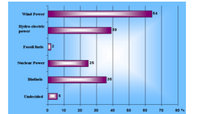 Electricity production preferences within own areas in 2002 (Source: Wind Engineering) ==
Electricity production preferences within own areas in 2002 (Source: Wind Engineering) == - Carbon Emissions carbon emissions in Sweden were originallyequivalent to approximately 5 tonnes per person. Comparatively, countries like the United States emitted around 20 tonnes per person. However, after the proposal of an oil phase-out some areas of Sweden have been able to reduce their CO2 emissions to 3.5 tonnes per person.
- Development of clean technologiesFor example, to heat water and produce electricity, a power plant in Vaxjo uses waste from the forestry industry. By burning this waste at high temperatures, the plant is able to generate electricity and heat the cooling water. The cooling water is not discarded like in conventional power plants. Instead, the water is carried up to 10 kilometers away by pipes and used as hot water in commercial and residential buildings.
- Transport sector Sweden increased its carbon-tax by 2.6% in 2008. In 2007, Stockholm began enforcing its congestion charges. Swedes traveling in and out of Stockholm's inner city zone must pay a toll that varies depending on the time of day and coincides with the amount of traffic. To motivate its citizens to switch from traditional gasoline vehicles to low-emission vehicles or public transportation, Sweden imposed a parking fee for gasoline vehicles but not for the low emission vehicles. Additionally, scientists are able to produce liquid fuels for vehicles from plant and tree cellulose; however, these fuels are not yet commercially possible alternatives.
- Passive house is an environmental standard with an economic incentive. These houses use recycled heat and highly efficient insulation so that they use less than 45 kilowatt hours of energy input per year. Sweden uses similar measures to reduce heating industrial buildings. In Stockholm, the body heat generated by the 250,000 commuters in central rail station heats the adjacent office building. The station can reach 85 degrees Fahrenheit. Instead of cooling the building, engineers devised a way to heat water with the excess heat. This water helps heat the office and reduces its heating bill significantly..
- Economic BenefitsDespite the initial concern that Sweden's economy would suffer because of the proposed oil phase-out, it has remained healthy so far. If used efficiently, Sweden's biofuels can be cheaper than oil products. After introducing carbon taxes, there was a push to find low-cost biological products that could produce energy and heat. Once there was a ban on dumping combustible waste in landfills, garbage collectors began paying for this waste to be used in the new biofuel power plants.
- Intelligent Street LightingIn 2007, the city of Gothenburg implemented an intelligent street lighting system. An intelligent street lighting system reduces energy consumption and costs while providing safe driving conditions and sufficient lighting to prevent crime. The lighting system in Gothenburg is especially efficient because it utilizes wireless communication enabling the street lights to automatically react to external factors such as traffic and weather conditions. For example, the level of lighting can be increased when streches of road are very congested, and the lighting can be dimmed at night when there are fewer vehicles on the road. According to Lonmark International, energy consumption by street lights in Gothenburg was reduced by 74% in only six months.
- Food LabelsIn October 2009, Sweden started listing carbon emissions on food labels. These new labels tell consumers how many kilograms of carbon released per kilogram of food product. The Swedish National Food Administration is behind this recent change. Last year, the Swedish National Food Administration was charged with the task of giving equal importance to climate and health through new food guidelines. These labels promote locally grown foods since less carbon is emitted to transport them. Similarly, they support seasonal produce since less energy is used to heat greenhouses and grow these products. The idea is to make people more conscious of the environmental impact of their choices, and if pepole followed these guidelines, it could help cut carbon emissions. According to estimates, food contributes as much as 25% of carbon emissions generated by industrialized nations.Note: This article was researched and written by a student at Boston University participating in the Encyclopedia of Earth's (EoE) Student Science Communication Project. The project encourages students in undergraduate and graduate programs to write about timely scientific issues under close faculty guidance. All articles have been reviewed by internal EoE editors, and by independent experts on each topic.This article used some material from the Wikipedia article Oil phase-out in Sweden. The Author(s) and Topic Editor(s) associated with this article have significantly modified the content derived therefrom with original content and with content drawn from other sources. All content from Wikipedia has been reviewed and approved by those Author(s) and Topic Editor(s), and is subject to the same peer review process as other content in the EoE. The current version of the Wikipedia article differs from the version that existed on the date of access. This article is licensed under the GNU Free Documentation License 1.2. See the EoE’s Policy on the Use of Content from Wikipedia for more information.==Sources==
- Sweden. Commission on Oil Independence. Making Sweden an Oil-Free Society. 21 June 2006.
- Robèrt, Markus,Per Hultén, and Björn Frostell. Biofuels in the energy transition beyond peak oil. A macroscopic study of energy demand in the Stockholm transport system 2030.Energy 32.11 (November 2007): 2089-2098.
- Wang,Y. Renewable electricity in Sweden: an analysis of policy and regulations. Energy Policy 34.10 (July 2006): 1209 - 1220.
- Rosenthal, Elisabeth. "To Cut Global Warming, Swedes Study their Plates." New York Times. 22 Oct. 2009
- "A synergy of Intelligent Street Lighting and Energy Conservation in Gothenburg, Sweden".Lonmark International Case Study
- McCormick, Kes, Philip Peck, and Tomas Kåberger.Breaking dependence on oil in Sweden: exploring the implications for biofuels.
- Devlin, Elizabeth. Factors Affecting Public Acceptance of Wind Turbines in Sweden Wind Engineering 29 (November 2005): 503–511.
- Fouché, Gwladys. Sweden's carbon-tax solution to climate change puts it top of the green list. The Guardian. 29 Apr. 2008.
- http://www.sweden.se/eng/Home/Work-live/Sustainability/Reading/Swedes-active-about-passive-houses/ Swedes active about passive homes.] <strong>Sweden.se Accessed on 22 Nov.</strong>
- Eriksson, Ola, Finnveden, Göran, Ekvall, Tomas, Björklund, Anna. LIfe Cycle Assesmentof fuels for district heating: A comparison of waste incineration, biomass- and natural gas combustion.Energy Policy. 25.2( February 2007): 1346 - 1362.
- Personal Communication with Henrik Selin. Department of International Relations. Boston University. 18 November 2009.==Further Reading==
- IEA Bioenergy: AnInternational Collaboration in Bioenergy
- Swedish Environmental Protection Agency
- Energy Agency
- Swedeish Energy Agency
- Alternatives to conventional crude oil: When, how quickly, and market driven?
- Introduction of a waste incineration tax: Effects on the Swedish waste flows. (Oil phase-out in Sweden)
- Kaufmann, Robert K. and Laura D. Shiers. faba63c02f47c5127b6abaae6b6a96ef4b1c715cc76ad7.90995139 Ecological Economics. 67.3 (February 2008): 405-411.
- Sahlin, Jenny, Tomas Ekvall, Mattias Bisaillon, and Johan Sundberg. faba63c02f47c5127b6abaae6b6a96ef4b1c715cc76ad7.90995139 Resources, Conservation, and Recycling. 51.4 (October 2007): 827-846.
-
